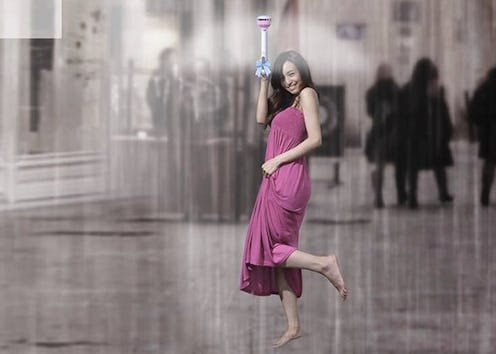News
China Just Invented The Invisible Umbrella

Umbrellas are the worst, and not just because Rihanna sang a song about them that made turned a three-syllable word into a seven-syllable one. They turn inside out, they track water into your home, and we leave them on busses and subways so often that we probably replace our umbrellas at least once a month (or is that just me?). But now, inventors in China have developed an invisible Air Umbrella that blows rain and snow away, and there's no way you'll ever forget this nifty contraption because it is just about the coolest thing to happen to rain since that color-changing dress on Project Runway (anyone, anyone?).
Never again will you have to worry about fitting your bulky umbrella through a door, or worse, down a subway stairway. Nor will you ever have to fight with your umbrella to get it to actually do its job instead of running away. The Air Umbrella, creating by Chuan Wang and a team based in Beijing and Nanjing, is a magical baton that fends off the rain and elements by blowing the rain away in an umbrella-shaped circle around you. In essence, you will be standing under a dome of air that will create the same effect as having a fabric barrier between yourself and the precipitation, but without the fabric.

The Air Umbrella looks a bit like an oversized flashlight, or perhaps a miniature staff. It has the capacity to create a safe space three feet in diameter, which means that the umbrella should be able to cover two people. But with a battery life of just 30 minutes, don't expect to take a long, romantic walk in the rain.
The air umbrellas come in a variety of sizes, ranging from the "b" or "basic" model, which is not specifically marketed towards the PSL loving, Instagramming, scarf-wearing (guilty of all) demographic, but rather the consumer looking for a standard sized umbrella. This version weighs a little more than a pound and a half, and stands at around 20 inches. There is the smaller "a" model, which is just a foot long and about a pound in weight, but has a shorter battery life of just 15 minutes. And then there is the extendable "c" model, which can be extended or retracted to be between 20 and 31 inches, which clocks in at just under two pounds.
Wang and his co-creators have started a successful Kickstarter campaign to further the development of the Air Umbrella, and with seven days left, they have already quintupled their $10,000 goal, with 440 backers pledging just under $53,000 to the cause.
On their Kickstarter profile, Wang explains that he first conceptualized the Air Umbrella idea a couple years ago, but only recently brought it to fruition:
One day in early 2012, I went by a building and there was water flowing down from the roof. I saw the straight water flow being bent by wind and the water that finally grounded was several meters deviating away from its original vertical position. At that point, an idea came to me that: if the wind was not blowing in one direction but blowing out from one center to all directions, such wind would shelter people from rain and it must be so cool for people to shelter from rain with such a portable airflow generator.
And that's exactly what the Air Umbrella is — a portable airflow generator. The inventors explain on Kickstarter that "flowing air can change the moving path of the object. The faster the air moves, the greater the energy is." This fast moving air creates a "jet airflow," which can actually push some objects away from us, in this case, rain. This, in turn, " forms an umbrella without a visible cover."
The best way to utilize your Air Umbrella would be to hold it perpendicular to the direction from which the rain or the wind is coming, similar to a real, physical umbrella. Of course, when the Air Umbrella blows rain away from you, it inevitably blows some of the water towards your neighbors, so be careful at who you're pointing the device at. The creators suggest keeping a distance of about two feet away from any fellow pedestrians to avoid deflecting raindrops onto them.
The other slight drawback is the noise the Air Umbrella emits as part of its motor. But as the creators continue to improve their design, they are confident that this nuisance will soon be addressed. In fact, they note that the umbrella already is much quieter than original models, which were apparently quite annoying, even if they were effective in keeping the rain away.
While Wang isn't the first to imagine an invisible umbrella — Korean designer Je Sung Park actually created a very similar design in 2010 — none of these previous iterations have ever gained much traction in the public sphere. But now, with Wang's highly successful Kickstarter campaign, supporters may be receiving their Air Umbrellas by next December. And if you'd like to get your hands on one yourself, they'll probably cost you in the range of $88 to $148, depending on the size you choose.
Of course, as with all Kickstarter funded projects, if Wang fails to deliver on this mythical umbrella, investors will receive a full refund. But with the technology behind this one, I'm willing to bet that this is an invention that will make a splash.
Images: Air umbrella/Kickstarter